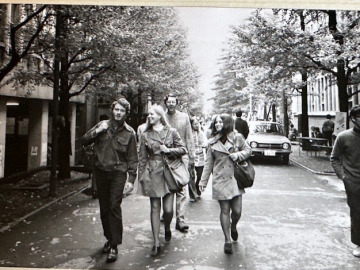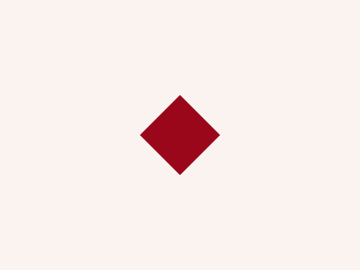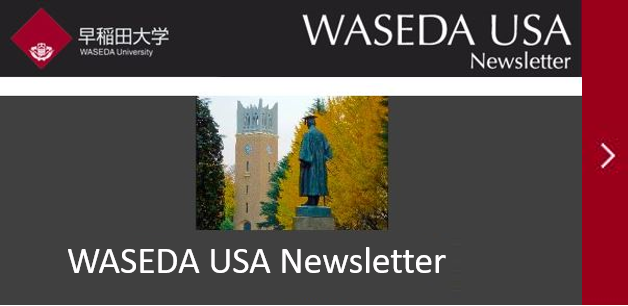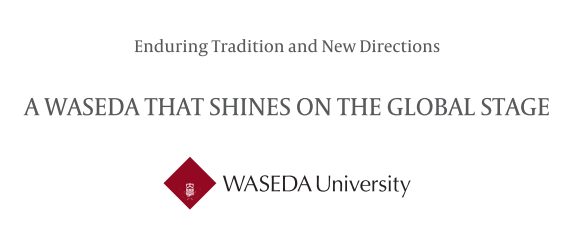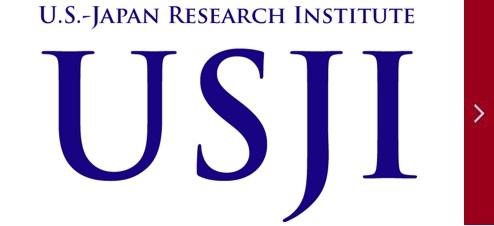My Waseda Experience
1988-1989 Kokusaibu
Robert Coldwell
(日本語は英語の次にあります)
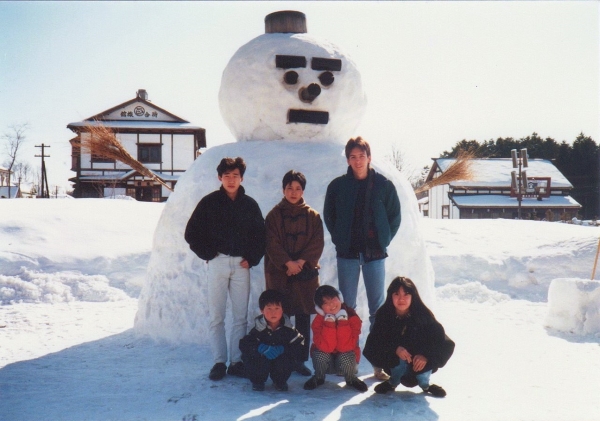
(February 1989, Sapporo)
In high school I began learning the guitar and excitedly read every new issue of popular guitar magazines. I can trace my first interest in Japan to an article about the Japanese band Loudness. Fortunately, the record store in my hometown of Tulsa, Oklahoma had many import albums and I was able to purchase music by Loudness and other Japanese bands. When I entered Occidental College in 1986, I was excited to learn more about Japan.
At Occidental I enrolled in Japanese language class with the wonderful Professor Lynne Miyake. This was at the peak of Japan’s economic boom and the classroom was overfilled. Students were standing along the walls and some had even come from Cal Tech. It was very exciting to see so much interest in Japan, but within 2 weeks half of the class dropped out once they realized how difficult it would be. I was undeterred and continued Japanese language classes, earning a minor upon graduation.
Through Professor Miyake I learned of the study abroad programs offered at Occidental. Already the move from Tulsa to Los Angeles was a huge culture shift for me and going to Japan seemed the next right place to go. Learning of my acceptance to the Waseda exchange program for my junior year was an exciting moment. I very clearly remember the start of the adventure boarding the flight in 1988 in Los Angeles with three classmates and students from other colleges and universities. The plane had to stop in Hawaii for refueling and stepping out of the plane to wait on the tarmac made it feel like even more of an adventure.
The arrival at Narita marked the start of an experience which would deeply impact the rest of my life. I remember trying to read every sign I saw on the bus ride to Tokyo. I learned much about Japan in my previous two years of language classes, but it did not prepare me for the rush of information and feelings from actually being there. The organization and attention of the CALPUC manager Sayoko Kono from our first arrival was amazing and I deeply appreciated her dedication throughout my time there.
My host parents, Katsumi and Kaneko Tamura, had hosted before so that is probably why they knew how to deal with a wide eyed exchange student struggling with such an overwhelming experience. They put me at ease and we had a wonderful relationship. Their son was about my age and was doing an exchange in Los Angeles. While I missed being able to get to know him, I felt that I was not an extra burden to the family and was filling in for him while he was away. During winter break I went to Hokkaido to stay with my host mother’s brother’s family and see the snow festival. At the end of the school year, instead of returning home immediately I stayed longer and went back to Hokkaido to work on the farm of my host mother’s cousin.
I placed into the highest level of Japanese language class, which made me proud of my hard work the past two years, but it was a massive challenge to keep up with the intense workload. Most students in the Kokusaibu at that time were economics or business majors. I was the only art major among the 40 or so students. The dean, Ikeda-sensei, was an art history professor and she took extra time to help me find studies outside of the normal classes. I remember her telling me that when the Kokusaibu was first founded most of the students were majoring in the arts, but the focus of the students had shifted over the years. She introduced me to some of her former students who were involved in Buddhist sculpture restoration. I was able to visit their studios occasionally during the school year and at the end of the year was invited to go to a large studio in Takadanobaba where they could teach me traditional tools and carving. These connections would prove to be valuable later as I worked to return to Japan for post-graduate studies.
While I enjoyed visiting Hokkaido, two of my other trips I value even more. My host family lived in Itabashi-ku and the local government was sponsoring students to travel to Hiroshima for the 50th anniversary of the atomic bombing. I was accepted and it was a very emotional experience that I can never forget. The other trip was with my Kokusaibu classmates to China. I knew little about China so I didn’t know what to expect and just tagged along. We went to Hong Kong and then found a tour to take us into China. We visited Guangzhou, Guilin and Beijing. We were in Beijing and toured Tiananmen Square a few months before the protests.
One of my extracurricular activities was in Waseda’s largest music club. The club created a band called International Heavy Metal with me as the lead guitarist. This was very exciting but also somewhat traumatic as I had never been in a band before or performed in front of anyone. We had two somewhat successful performances, and the opportunity to meet more Waseda students and participate in their activities was memorable.
Leaving Japan at the end of the school year in 1989 was sad, yet I knew I could find a way to come back. I finished my art major and intended to become a sculpture professor. This would require an MFA but my first round of applications was not successful. I remained in Los Angeles taking non-degree classes at what is now called Otis College of Art and Design and worked at the Pacific Asia Museum in Pasadena. I continued taking private Japanese language lessons and investigated ways to study in Japan again.
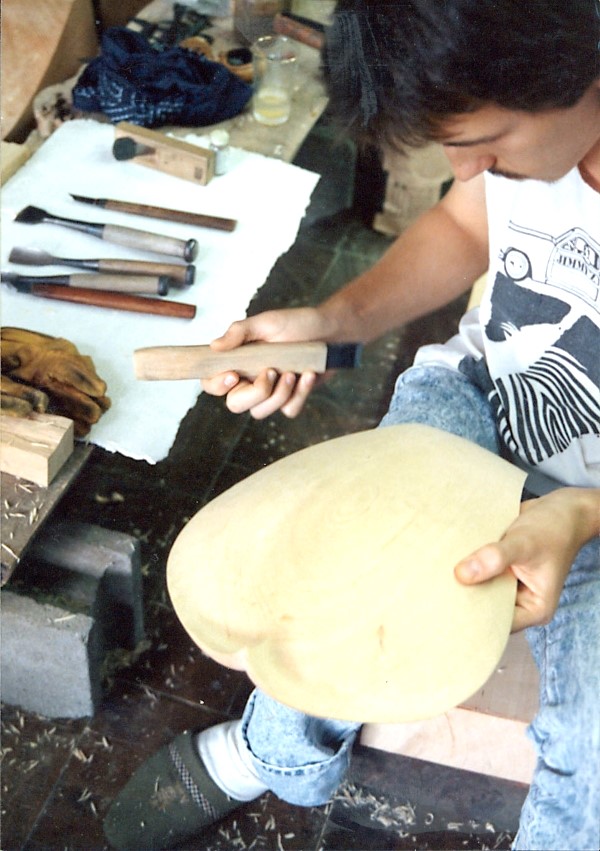
(May 1989, Takadanobaba)
After a second round of graduate school applications failed I decided to travel back to Japan to network in person. Ikeda-sensei’s former students gave me some opportunities to help them in their studios while I supported myself by teaching English. Both of them had attended what is now called the Tokyo University of the Arts, commonly known as Geidai, studying the restoration of historical sculptures. They introduced me to their professor, Ichiro Nagasawa. Professor Nagasawa said I should complete graduate school in the US first before attempting to apply to Geidai. My third attempt at graduate school applications succeeded and I enrolled at San Jose State University to study sculpture. While there I learned of the Japanese Government Scholarship program (Monbugakusho). During my interview for the scholarship at the San Francisco consulate I was told art students rarely receive this scholarship. This saddened me, but made my eventual acceptance even more joyful.
In 1995 I arrived in Japan yet again as a student. The Monbugakusho would support me at Geidai for three years, first as a non-degree student and then as a degree student. I was able to spend time with my Waseda friends and host family, but more importantly was able to now focus on Japanese sculpture. The experience was amazing during those three years visiting temples and learning how to preserve ancient sculptures. It was here that I met my wife, a classmate in the sculpture department. She is an artist from Beijing whose father was an opera singer and mother a painting professor at a university. Our common language during those three years was only Japanese.
Upon graduation from Geidai I had an opportunity to join the Bijyutsuin in Kyoto, an organization dedicated to preserving and restoring Japanese national treasures. Unfortunately, I had to make a very difficult decision to return to the US for health reasons. I continue to visit Japan every few years to see my host family and friends from Geidai.
My experience at the Kokusaibu truly changed the direction of my life. The organization of the host families, classes, and outings made the experience so valuable and memorable. Being in the middle of a major university affords many opportunities to engage with students and faculty outside the Kokusaibu, which could not be equaled elsewhere.
高校生だったころにギターを習い始め、流行っていたギター雑誌の新刊を、毎回ワクワクしながら読んでいました。私が初めて日本に興味を持ったきっかけは、日本のバンド「ラウドネス」についての記事でした。幸いなことに、私の故郷であるオクラホマ州タルサのレコード店には輸入アルバムがたくさんあり、ラウドネスや他の日本のバンドの音楽を購入することができました。1986年にオクシデンタルカレッジに入学したとき、私は日本についてもっと学べることを期待していました。
オクシデンタルでは、素晴らしい方であるLynne Miyake教授の日本語クラスに入りました。当時は日本経済の絶頂期で、教室は定員オーバーでした。学生は壁に沿って立っていて、中にはカリフォルニア工科大学から来た学生もいました。日本への関心の高さを目の当たりにして、とても嬉しかったのですが、2週間もしないうちに、授業の難しさを知って、クラスの半分が脱落してしまいました。私はめげずに、日本語の授業を取り続け、卒業時には副専攻を取得しました。
Miyake教授を通じて、オクシデンタルで提供されていた留学プログラムについて知りました。タルサからロサンゼルスへの移動は、私にとって大きなカルチャーシフトだったのですが、次に行くべき場所を考えた時、日本を思い浮かべたことはとても自然なことでした。3年生の時に、早稲田大学の交換プログラムへの参加が認められたことを知った瞬間は、最高でした。1988年、ロサンゼルスで3人のクラスメートと他大学の学生とともに飛行機に乗ったとき、冒険の始まりだった気持ちをとてもはっきりと覚えています。飛行機は給油のためにハワイに立ち寄らなければならず、飛行機から降りて駐機場で待っていると、さらに冒険気分が高まりました。
成田への到着は、私の残りの人生に大きな影響を与える経験の始まりを意味していました。東京行きのバスに乗っていた時に見かけた標識を、全部読もうとしたのを覚えています。それまでの2年間の語学授業で日本について多くのことを学んだのですが、実際に日本にいることで奔流してくる情報や感情は、予測できないものでした。当時CALPUCのマネージャーであったSayoko Konoは、私たちが最初に到着したときから、その段取りと気配りが素晴らしく、私が滞在していた間、彼女が献身的にサポートしてくれたことに深く感謝しています。
私のホスト ペアレントであった田村勝美さんと兼子さんは以前にその経験があったので、圧倒されるような経験に苦慮している、目を皿にした交換留学生に対処する方法を知っていたのでしょう。安心感を与えてくれて、素晴らしい関係を築くことができました。彼らの息子は私と同じくらいの年齢で、ロサンゼルスで交換留学をしていました。彼と知り合うことができなくて寂しかったのですが、私は家族にとってプラスの負担ではなく、彼の留守中の代役を務めているのだと感じました。冬休みの間、私はホストマザーの兄弟の家族と一緒に北海道に滞在し、雪まつりを観に行きました。学年の終わりに、すぐに帰国するのではなく、長居して北海道に戻り、ホストマザーの従兄弟の農場で働きました。
私は最高レベルの日本語クラスに入ったので、それまでの2年間の頑張りを誇りに思いましたが、厳しい課題についていくのは大変でした。当時の国際部の学生の多くは、経済学や経営学を専攻していました。40人ほどの学生の中で、美術を専攻していたのは私一人でした。 学部長の池田先生は美術史の教授で、通常の授業以外の研究活動の機会を探すのを手伝ってくれました。国際部が設立された当初、ほとんどの学生は人文科学を専攻していましたが、学生の興味関心は長年にわたって変化していったと彼女が私に説明したのを覚えています。彼女は、仏像の修復に携わっていた教え子を何人か紹介してくれました。学期中は時々彼らの工房を訪れることができ、年末には高田馬場の大きな工房に招待され、伝統的な道具や彫刻を教えてもらいました。こうした繋がりは、後に大学院留学のために渡日する準備をしていた時に、どれだけ貴重だったかを知ることになりました。
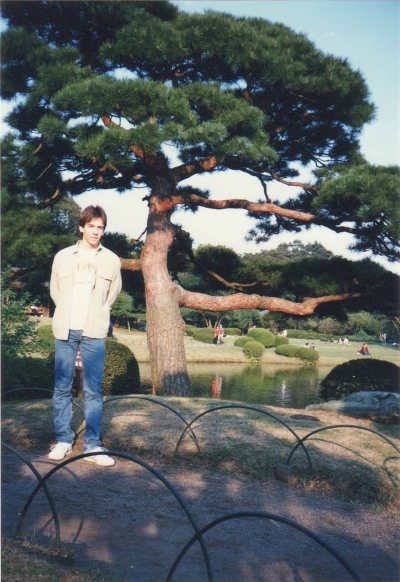
(September 1988, Shinjuku Park)
旅行では、北海道も楽しかったのですが、さらに自分にとって意義があった二つの旅がありました。私のホストファミリーは板橋区に住んでいて、その自治体は原爆投下50周年を記念して広島へ旅行する学生を支援していました。私はそのプログラムに受け入れられ、決して忘れることのできない非常に感動的な経験をすることができました。もう一つは国際部の同級生との中国旅行でした。私は中国のことをほとんど知らなかったので、何もわからず、ただただ付き合わされただけでした。香港に行き、その後、中国に入るツアーを見つけました。広州、桂林、北京を訪れました。北京では、周知のデモの数ヶ月前に天安門広場を見学しました。
私の課外活動の 1 つは、早稲田最大の音楽クラブでした。そのクラブは、「インターナショナル・ヘビーメタル」というバンドを作り、私がリードギタリストを担当しました。バンド活動も人前で演奏する経験もなかった私にとって、それはとてもエキサイティングなことでしたが、同時に忘れられない思い出にもなりました。2回の公演は概ね成功し、より多くの早大生と出会い、その活動に参加できたことがとても印象に残っています。
1989年の学年末に日本を離れた時は悲しかったですが、きっとまた戻る方法を見つけられると信じていました。私は美術専攻を卒業し、彫刻を専門とする教授になることを希望していました。しかしそれにはMFAの取得が必要であり、一回目の応募は不合格でした。私はロサンゼルスに残り、現在の「オーティス・カレッジ・オブ・アート・アンド・デザイン」で非学位プログラムのクラスを受講し、それからパサデナのパシフィックアジア美術館で働きました。日本語の個人レッスンを受け続け、再び日本留学の方法を検討しました。
大学院への2回目の出願が不合格になった後、私は日本に戻って直接ネットワークを構築することにしました。池田先生の教え子たちから、工房の手伝いをする機会をいただき、英語を教えることで生活を支えていました。教え子の二人とも、現在の東京藝術大学、通称「藝大」に通い、古代彫刻の修復を研究していました。彼らの紹介で、長澤市郎教授に知り合いました。長澤先生は、藝大に応募する前にまずアメリカの大学院を卒業するべきだ、とのアドバイスをくださいました。そして3度目の大学院受験に成功し、サンノゼ州立大学大学院に入学し、彫刻を学びました。そこで、日本政府の奨学金制度(文部科学省)があることを知りました。サンフランシスコ領事館で奨学金の面接を受けたとき、美術専攻の学生がこの奨学金を受け取ることはめったにないと言われました。そのことを聞いて少し悲しく思ったのですが、最終的に受け入れられたときには、そのためかさらに嬉しく思ったものです。
1995年、私は学生として再び日本に行きました。文部科学省は、藝大での3年間、最初は非学位プログラムの学生として、それから学位取得プログラム学生として、私を支援してくれました。早稲田大学の友人や私のホストファミリーと一緒に時間を過ごすことができましたが、それよりも重要だったのは、日本彫刻に集中することができたことでした。寺院を訪れ、古代の彫刻を保存する方法を学んだ3年間は、素晴らしい経験でした。そこで出会ったのが、当時彫刻科の同級生であり、後の私の妻でした。彼女は、父はオペラ歌手、母は絵画を専門とする大学教授という、北京出身の芸術家です。この3年間、私たちの共通言語は日本語だけでした。
藝大を卒業すると、京都の美術院という日本の国宝を保存・修復する団体に入る機会を得ました。残念ながら、健康上の理由でアメリカに戻るという非常に難しい決断をしなければなりませんでした。今もホストファミリーや藝大の友達に会うために、数年おきに日本を訪れています。
国際部での経験によって、私の人生の方向が大きく変わりました。ホストファミリー、授業、旅行などの一連の貴重な機会により、とても貴重で思い出深い経験をすることができました。素晴らしいそして大きな大学の中にいたことで、国際部以外の学生や教員と交流する多くの機会を得ることができましたが、それは他では得られない、自分の人生にとって本当に価値あるものとなりました。

